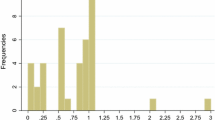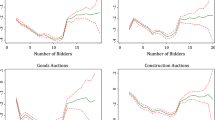Abstract
We study the optimal procurement mechanism when contract breach and abandoning a project may be efficient, either because of completion costs higher than anticipated or because of new and more lucrative opportunities for the contractor. When contractors have private information about their costs, the procurer finds it optimal to set damages above expectation damages. There is a lock-in effect, or status quo bias; the agent that has won the award will complete the project even in situations when it would be efficient to abandon it. If the cost types of all agents are above a threshold, the optimal bidding procedure assigns the project by lottery. The optimal mechanism cannot be implemented by standard auction formats. However, the larger the number of agents bidding for the project, the closer auctions with a liquidated damage clause approximate the optimal mechanism.
Similar content being viewed by others
Notes
According to construction management professionals, a large number of USA construction firms stay in business for a short time. For example, Ganaway (2006) claims that only 43 % of U.S. construction firms remain in business after 4 years. The situation is not much different in other countries.
Performance bonds and third party guarantees like letters of credit and surety bonds are also used.
Expectation damages is the legal term for the ex-ante expected loss to the principal.
In most civil law countries, penalty clauses are enforceable, but they may be mitigated by the courts.
Procedures that exclude bids automatically have been recently opposed by the EU Commission, because of their anticompetitive flavor, and now they can be used in the EU only for awarding contracts of limited amount (e.g., up to 1 million euros in the case of Italy)—this exemption is explicitly justified by the high costs of testing bidder reliability in the case of small projects. The many shortcomings of bidding procedures Footnote 6 continued that exclude abnormally low tenders have been studied by Albano et al. (2006) and Decarolis (2011). Recent studies of alternative procurement procedures include Postl (2012) and Rezende (2009).
In public procurement, awarding projects by lottery is not unheard of. As an example, consider the auction to build a police station in the Sicilian municipality of Palma di Montechiaro. The auction rules required to eliminated the 10 % highest and the 40 % lowest reductions over the base price and then to pick as winner the bid closest to the average of the remaining bids. There were exactly 24 bids closest to the average and the actual winner was determined by a lottery draw. Our paper uncovers settings were lotteries might be optimal, but it is well known that they are highly inefficient in many circumstances (e.g., see Milgrom 2004); we do not advocate their generalized use as allocation mechanisms. We refer again to Footnote 7 continued Albano et al. (2006) and Decarolis (2011) for a discussion of the shortcomings of bidding procedures that exclude abnormally low tenders.
Ramchurn et al. (2009) show that by rewarding all bidders in case of success and penalizing them in case of failure, efficiency can be obtained even in the case of multidimensional private information.
As will become clear later, in the optimal contract, the participation fee \( t_{i}^{L}\) could be set to be equal to zero for all cost types; charging the losing agents is not necessary.
To simplify notation, here and in the remainder of the paper, we replace \( \min \left\{ p_{i}+k_{i},c^{+}\right\} \) with \(p_{i}+k_{i}\) as the highest opportunity cost \(c\) at which the project is completed, exploiting the fact that \(f(c)=0\) and \(F(c)=1\) for \(c>c^{+}\).
\(S_{i}^{1}\) increases with \(p_{i}\) if \(p_{i}<V\) and decreases in \( p_{i}\) if \(p_{i}>V\).
Since \(V\) is the project’s benefit, it is also equal to the principal’s damages if the project is not completed.
An alternative way to implement the optimal mechanism is to charge all agents a positive participation fee \(t_{i}^{L}\); the fee amounts \(t_{i}^{L}\) clearly decrease with the number of bidders \(N,\) as an increase in \(N\) decreases the probability of winning the project (and hence making a profit).
For values of \(k^{T_{2}}<k^{-}\), define \(\frac{G\left( k^{T_{2}}\right) }{ g\left( k^{T_{2}}\right) }=0.\) For values of \(k^{T_{2}}>k^{+}\), define \(\frac{ G\left( k^{T_{2}}\right) }{g\left( k^{T_{2}}\right) }=\frac{G\left( k^{+}\right) }{g\left( k^{+}\right) }.\)
References
Albano, G., Bianchi, M., Spagnolo, G.: Bid average methods in procurement. Riv. Polit. Econ. 1–2, 41–62 (2006)
Asker, J.: Bidding up, buying out and cooling-off: an examination of auctions with withdrawal rights. Econ. Theory 16, 585–611 (2000)
Board, S.: Bidding into the red: a model of post-auction bankruptcy. J. Financ. 62, 2695–2723 (2007)
Burguet, R., Ganuza, J.J., Hauk, E.: Limited liability and mechanism design in procurement. Game Econ. Behav. 76(1), 15–25 (2012)
Chung, T.Y.: On the social optimality of liquidated damage clauses: an economic analysis. J. Law Econ. Organ. 8, 280–305 (1992)
Decarolis, F.: When the highest bidder loses the auction: theory and evidence from public procurement. (2011, unpublished)
Eidlin, A.S., Reichelstein, S.: Holdups, standard breach remedies and optimal investment. Am. Econ. Rev. 86, 478–501 (1996)
Edlin, A.S., Schwartz, A.: Optimal penalties in contracts. Chicago-Kent Law Rev. (2003). Available at: http://works.bepress.com/aaron_edlin/30
Ganaway, N.B.: Construction Business Management: A Guide to Contracting for Business Success. Butterworth-Heinemann, Oxford (2006)
Milgrom, P.: Putting Auction Theory to Work. Cambridge University Press, Cambridge (2004)
Parlane, S.: Procurement contracts under limited liability. Econ. Soc. Rev. 34, 1–21 (2003)
Postl, P.: Efficiency versus optimality in procurement. Econ. Theory (2012). doi:10.1007/s00199-012-0699-x
Ramchurn, S.D., Mezzetti, C., Giovannucci, A., Rodriguez-Aguilar, J.A., Dash, R.K., Jennings, N.J.: Trust-based mechanisms for robust and efficient task allocation in the presence of execution uncertainty. J. Artif. Intell. Res. 35, 119–159 (2009)
Rezende, L.: Biased procurement auctions. Econ. Theory 38, 169–185 (2009)
Rhodes-Kropf, M., Viswanathan, S.: Financing auction bids. Rand J. Econ. 36(4), 789–815 (2005)
Spulber, D.F.: Auctions and contract enforcement. J. Law Econ. Organ. 6(2), 325–344 (1990)
Stole, L.A.: The economics of liquidated damage clauses in contractual environments with private information. J. Law Econ. Organ. 8, 582–606 (1992)
Von Ungern-Sternberg, T.: Swiss auctions. Economica 58, 341–357 (1991)
Waehrer, K.: A model of auction contracts with liquidated damages. J. Econ. Theory 67(2), 531–555 (1995)
Wan, Z., Beil, D.R.: RFQ auctions with supplier qualification screening. Oper. Res. 57(4), 934–949 (2009)
Zheng, C.Z.: High bids and broke winners. J. Econ. Theory 100(1), 129–171 (2001)
Zheng, C.Z.: The default-prone US toxic asset auction plan. B.E. J. Econ. Anal. Policy 38(1), 41–72 (2009)
Author information
Authors and Affiliations
Corresponding author
Additional information
Financial support from Fondazione Cariparo is gratefully acknowledged.
Appendix
Appendix
In this appendix, first we prove a lemma that deals with the second-order condition of the agents’ reporting problem. Then, we provide a proof of Propositions 4 and 5.
Lemma 1
Consider the mechanism described by the functions \( p_{i}(k_{i},k_{-i}),\) \(t_{i}(k_{i},k_{-i}),\) \(\pi _{i}(k_{i},k_{-i})\) for all \(i.\) Suppose that (a) \(p_{i}(k_{i},k_{-i})=p_{i}\left( k_{i}\right) \) (i.e., \(p_{i}\) does not depend on the types \(k_{-i})\); (b) \( p_{i}(k_{i})\) is increasing in \(k_{i}\) and differentiable; (c) \(\Pi _{i}(k_{i})=\int \nolimits _{K_{-i}}\pi _{i}(k_{i},k_{-i})g_{-i}(k_{-i})\text{ d }k_{-i}\) exists and is (weakly) decreasing in \(k_{i}.\) If this mechanism satisfies the first-order condition of the agent’s reporting problem, then it also satisfies the second-order condition, and hence, it is incentive compatible.
Proof
Consider the first-order condition of agent \(i\) reporting problem:
Differentiating it totally yields
Since
under the hypotheses of the lemma, we can write the second-order condition as:
\(\square \)
Proof of Proposition 4
Consider first a second-price, bonus auction. Let \(\beta (k_{i})\) be the bidding function (for notational simplicity, we drop the dependence on \(t\)) and assume provisionally that it is strictly increasing everywhere. Let \(Q(k)=[1-G(k)]\) . We can write bidder \(i\)’s problem of determining the optimal value of his bid \(b\) as:
The first-order condition is
which yields, using the Nash equilibrium condition \(b=\beta (k_{i})\),
or
It is immediate to see that the second-order condition is satisfied and that Eq. (6) defines the equilibrium bidding function, as long as \( \beta (k_{i})\) is strictly increasing. To see that \(\beta \left( k_{i}\right) \) is increasing, note that if we differentiate (5) with respect to \(k_{i}\), we obtain
and hence,
Using (6), we see that \(\beta \left( k_{i}\right) +k_{i}+t<c^{+}\) for types \(k_{i}\) such that \(k_{i}<c^{+}-E\left[ c\right] -t\). Thus, we have shown that if \(k_{i}<c^{+}-E\left[ c\right] -t\), then bidder \(k_{i}\) will bid according to \(\beta \left( k_{i};t\right) .\)
Now suppose \(\beta \left( k_{i}\right) +k_{i}+t\ge c^{+}\) or, equivalently, \(k_{i}\ge c^{+}-E\left[ c\right] -t\). When winning, bidder \(k_{i}\) will complete the contract with certainty and therefore must bid no less than the expected cost; furthermore, he will certainly lose the auction if he asks for more than the expected cost. It follows that the equilibrium bid is \(E \left[ c\right] .\) Thus, since \(\beta \left( k_{i}\right) =E\left[ c\right] \) for \(k_{i}\ge c^{+}-E\left[ c\right] \), bidding according to \(\beta \left( k_{i}\right) \) is also an equilibrium for these types.
Now consider a second-price, up-front-payment auction. Let \(p\) be the damages and \(b(k_{i})\) be the bidding function (for notational simplicity, we drop the dependence on \(p\)) and assume provisionally that it is strictly increasing everywhere. We can write bidder \(i\)’s problem of determining the optimal value of his bid \(\widetilde{b}\) (the up-front payment) as:
The first-order condition is
which yields, using the Nash equilibrium condition \(\widetilde{b}=b(k_{i};p): \)
It remains to check that \(b\) is increasing in \(k_{i}\). This follows immediately:
Note that the fact that \(b\) is increasing also implies that the second-order condition holds. \(\square \)
Proof of Proposition 5
Observe from (4) that
Let \(k^{(1)}\) be the lowest cost type, \(k^{(2)}\) be the second lowest cost type, and \(g_{k^{\left( 1\right) },k^{\left( 2\right) }}(x,y)\) be their joint density. The principal chooses \(p\) to maximize
which yields the first-order condition
or
from which we obtain
Since \(k^{(1)}<k^{(2)}\), it is immediate to see that the optimal damage clause is \(p>V\) as long as \(V+k^{-}<c^{+}.\) If \(V+k^{-}\ge c^{+}\), then \( F\left( V+k_{1}\right) =F\left( V+k_{2}\right) =1\) for all \(k_{1},k_{2}\) and \(p=V.\) \(\square \)
Rights and permissions
About this article
Cite this article
Chillemi, O., Mezzetti, C. Optimal procurement mechanisms: bidding on price and damages for breach. Econ Theory 55, 335–355 (2014). https://doi.org/10.1007/s00199-013-0751-5
Received:
Accepted:
Published:
Issue Date:
DOI: https://doi.org/10.1007/s00199-013-0751-5




